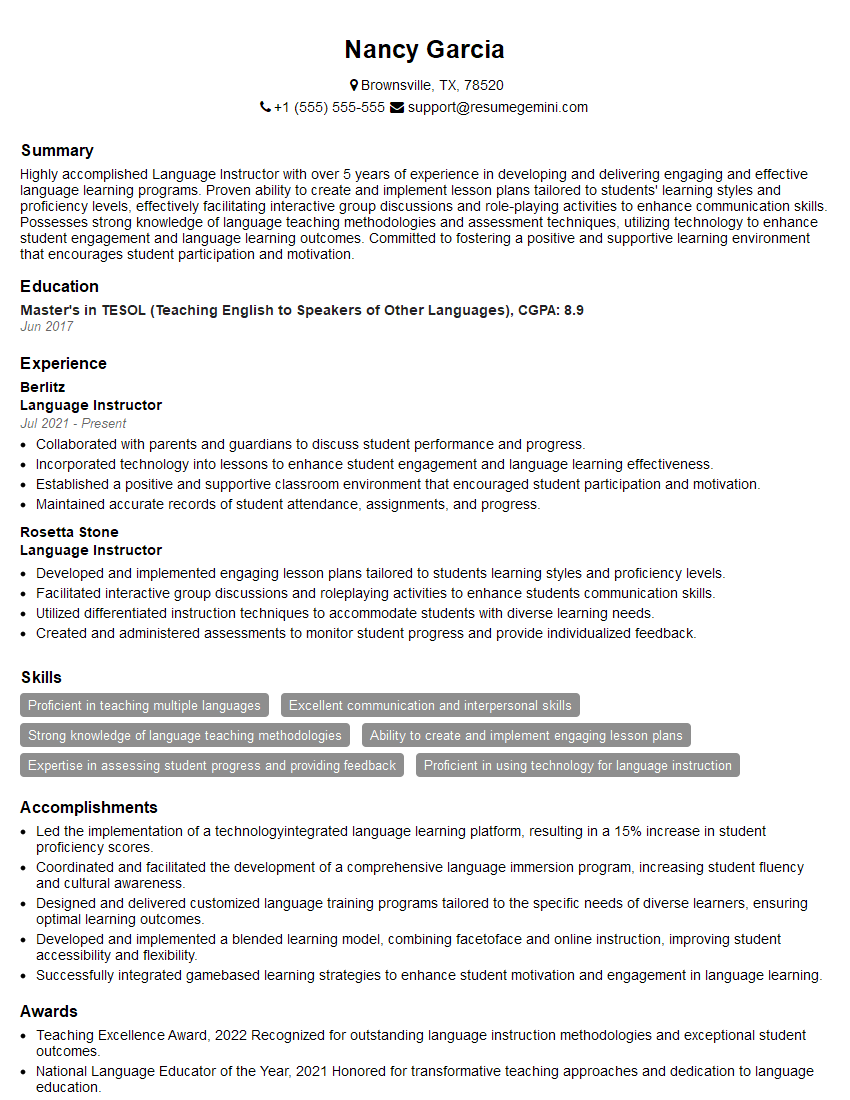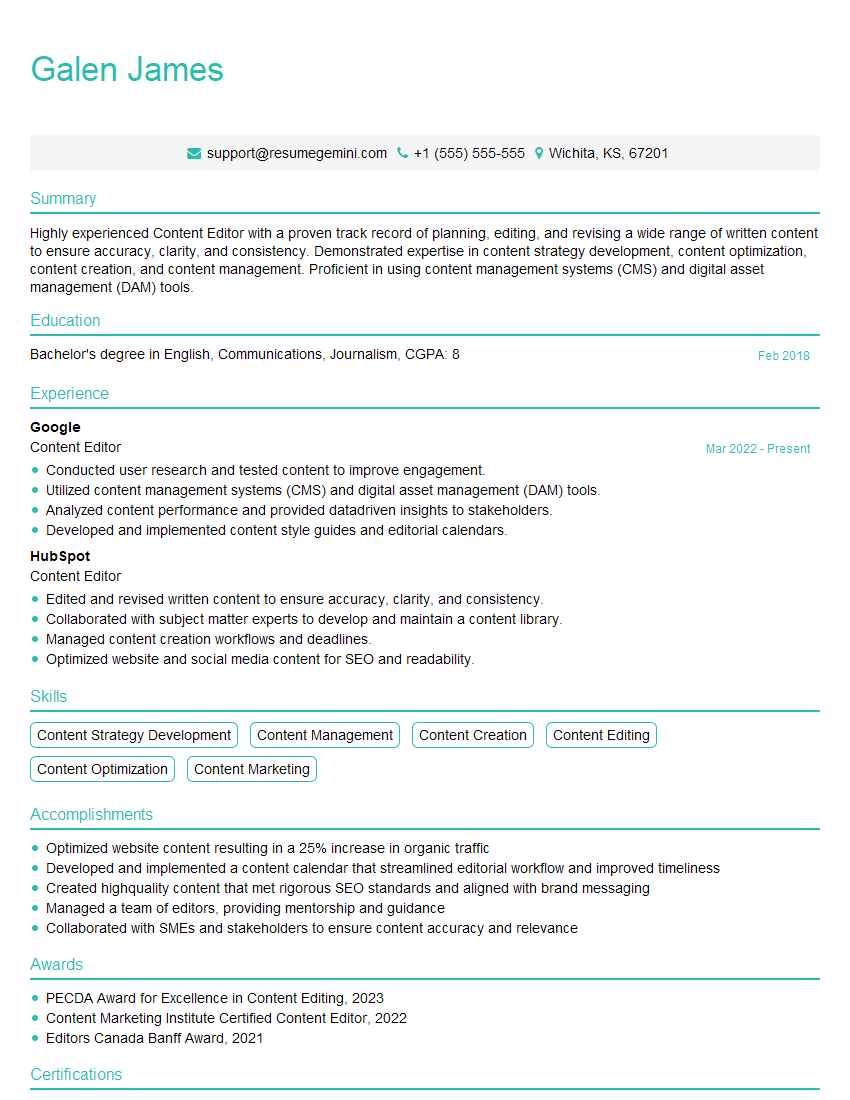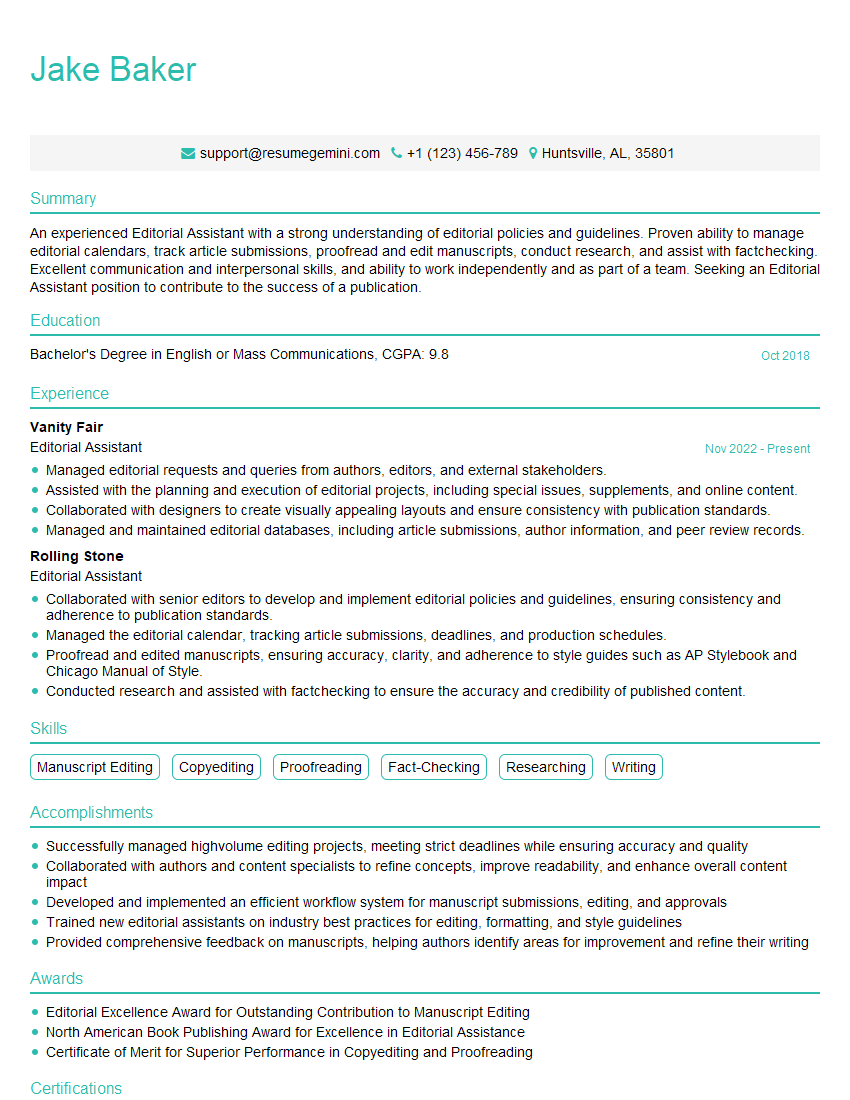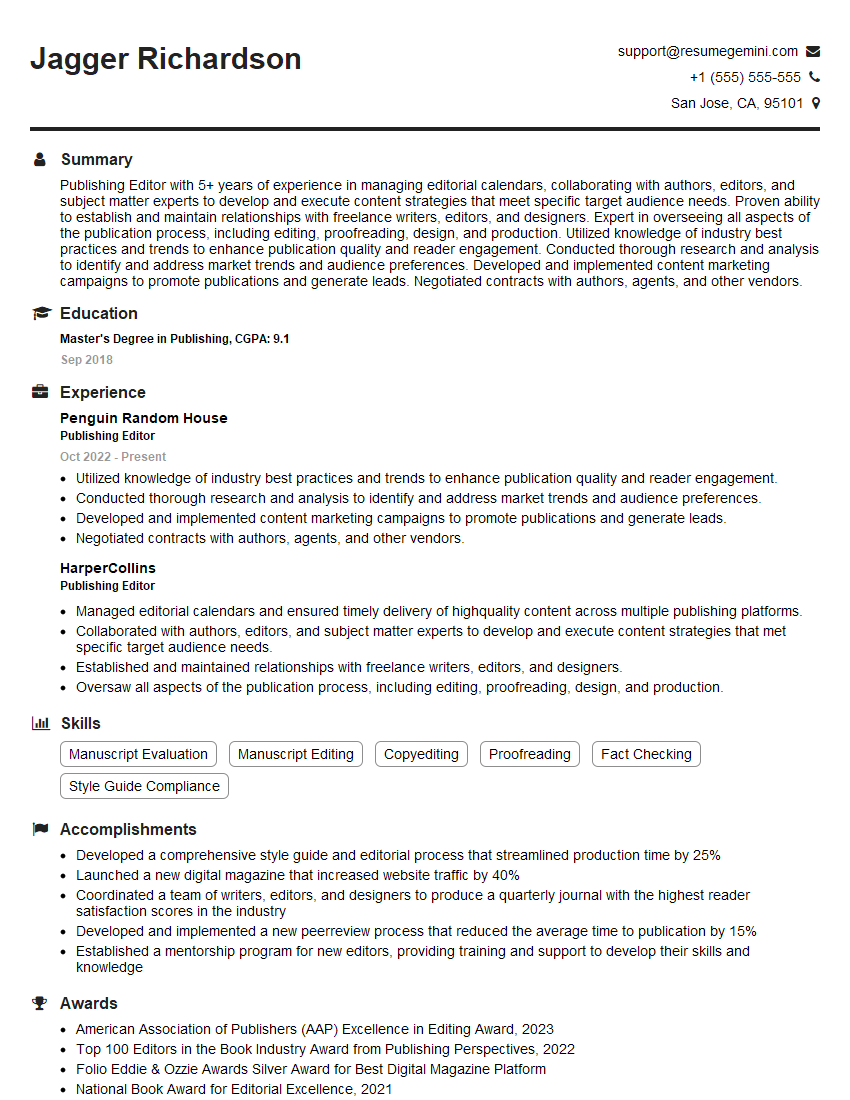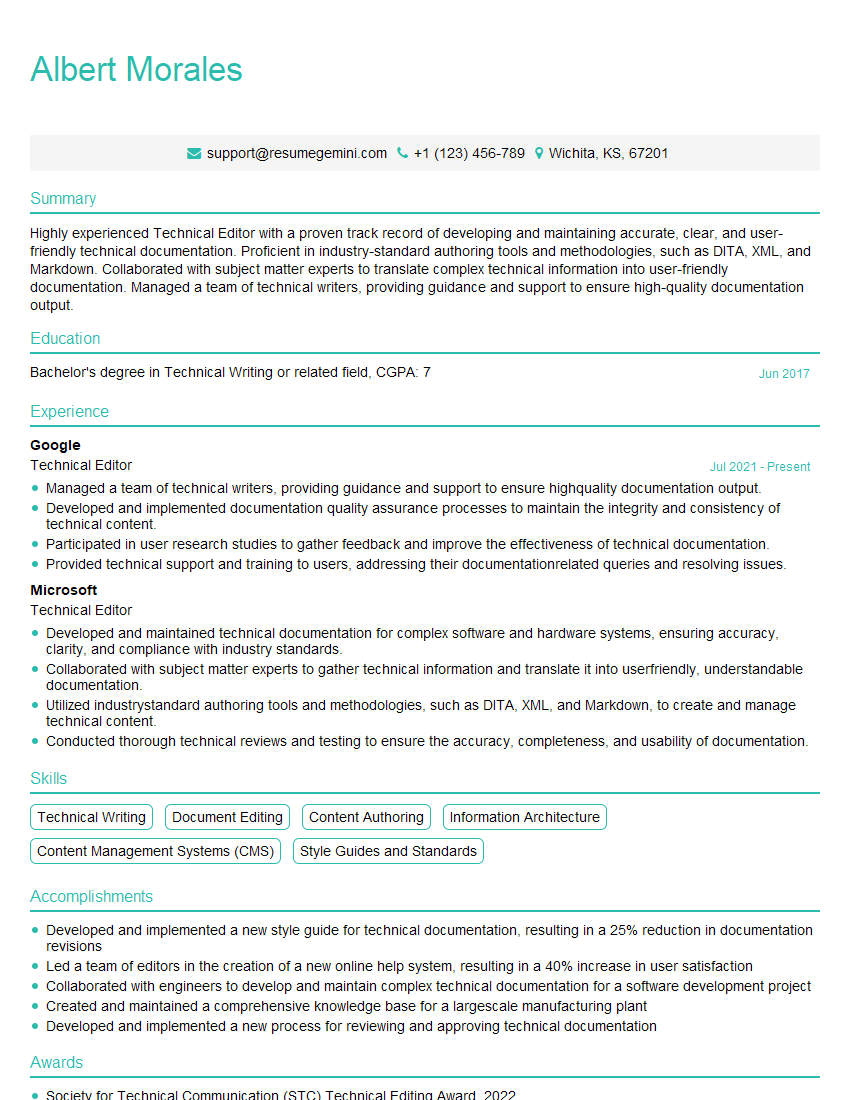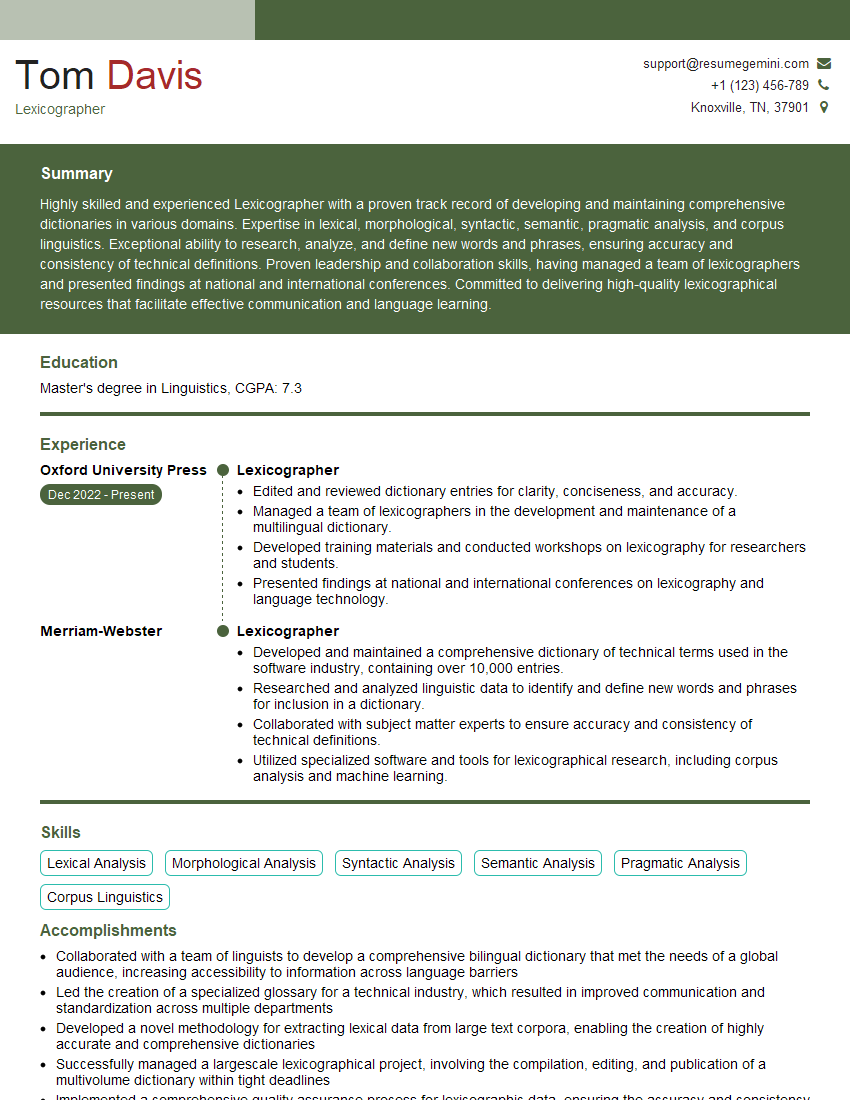Every successful interview starts with knowing what to expect. In this blog, we’ll take you through the top Grammar and Syntax Knowledge interview questions, breaking them down with expert tips to help you deliver impactful answers. Step into your next interview fully prepared and ready to succeed.
Questions Asked in Grammar and Syntax Knowledge Interview
Q 1. Define syntax and explain its role in communication.
Syntax is the set of rules, principles, and processes that govern the structure of sentences in a given language, specifically word order. Think of it as the grammar of sentence construction. Its role in communication is crucial because it dictates how we arrange words to create meaningful and understandable messages. Without proper syntax, our communication would be chaotic and ambiguous, like a puzzle with missing pieces.
For example, the sentence “The cat sat on the mat” follows English syntax. Reordering the words, like “Mat the on sat cat the,” renders the sentence nonsensical, even though all the words remain the same. Effective syntax ensures clarity, precision, and avoids misinterpretations in any form of communication, from casual conversation to formal writing.
Q 2. What are the main parts of speech and their functions?
The main parts of speech are the building blocks of sentences. They each have specific roles and functions:
- Nouns: These are words that represent people, places, things, or ideas (e.g., dog, city, happiness, concept). They function as the subjects or objects of verbs.
- Pronouns: These replace nouns to avoid repetition (e.g., he, she, it, they, we). They also function as subjects or objects.
- Verbs: These are action words or states of being (e.g., run, jump, is, are, seems). They describe what the subject does or is.
- Adjectives: These describe nouns (e.g., big, red, happy, intelligent).
- Adverbs: These describe verbs, adjectives, or other adverbs (e.g., quickly, loudly, very, extremely).
- Prepositions: These show the relationship between a noun or pronoun and another word in the sentence (e.g., on, in, at, above, below). They often introduce prepositional phrases.
- Conjunctions: These connect words, phrases, or clauses (e.g., and, but, or, because, so).
- Interjections: These express strong emotion (e.g., Wow! Ouch! Help!).
Understanding these parts of speech is fundamental to constructing grammatically correct and effective sentences.
Q 3. Explain the difference between a phrase and a clause.
The difference between a phrase and a clause lies in the presence of a subject and a verb. A phrase is a group of related words that does not contain a subject-verb pair. It functions as a single unit within a sentence. A clause, on the other hand, does contain a subject-verb pair. It can be a complete sentence (independent clause) or part of a larger sentence (dependent clause).
Example:
Phrase: “with a bright smile” (no subject or verb)
Clause: “She smiled brightly.” (subject: She, verb: smiled)
The phrase modifies the verb in the clause, adding more detail. Understanding this distinction is critical for analyzing sentence structure and avoiding grammatical errors.
Q 4. Differentiate between active and passive voice. Give examples.
Active voice emphasizes the subject performing the action. Passive voice emphasizes the action itself and often omits the actor.
Active Voice Example: The dog chased the ball.
(Subject: dog, Verb: chased, Object: ball)
Passive Voice Example: The ball was chased by the dog.
(Subject: ball, Verb: was chased, Agent: by the dog)
In active voice, the sentence is more direct and concise. Passive voice can be useful when the actor is unknown or unimportant, or when you want to emphasize the action rather than the doer. However, overuse of passive voice can make writing sound weak and indirect.
Q 5. Identify and correct grammatical errors in a given sentence.
Please provide the sentence you would like me to correct. I need the sentence to identify and correct the grammatical errors.
Q 6. Explain the concept of subject-verb agreement.
Subject-verb agreement means that the verb in a sentence must agree in number (singular or plural) with its subject. A singular subject takes a singular verb, and a plural subject takes a plural verb.
Examples:
Singular: The dog barks loudly.
Plural: The dogs bark loudly.
It’s important to identify the true subject, even when intervening phrases might seem to complicate matters. For instance, in the sentence “The box of chocolates is delicious,” the subject is “box,” not “chocolates,” so we use the singular verb “is.”
Subject-verb agreement is crucial for clear and grammatically correct writing.
Q 7. What is a dangling modifier? Provide an example and correction.
A dangling modifier is a word or phrase that modifies a word not clearly stated in the sentence. It creates ambiguity and confusion. It usually occurs at the beginning of the sentence and appears to describe the subject that follows it but does not actually do so.
Example:
Walking down the street, the car suddenly stopped.
This sentence implies the car was walking down the street! The correct sentence would clearly state who is doing the walking.
Correction:
Walking down the street, I saw the car suddenly stop.
Now it’s clear that “I” was doing the walking. Identifying and correcting dangling modifiers improves sentence clarity and avoids misinterpretations in your writing.
Q 8. Describe the different types of sentence structures (simple, compound, complex, compound-complex).
Sentence structure refers to the arrangement of words, phrases, and clauses to create a complete thought. There are four main types:
- Simple Sentence: Contains one independent clause (a clause that can stand alone as a sentence). Example:
The dog barked. - Compound Sentence: Contains two or more independent clauses, joined by a coordinating conjunction (e.g., and, but, or, nor, for, so, yet) or a semicolon. Example:
The dog barked, and the cat hissed.orThe dog barked; the cat hissed. - Complex Sentence: Contains one independent clause and one or more dependent clauses (clauses that cannot stand alone as a sentence). Example:
Because the dog barked, the cat hissed.(Dependent clause is ‘Because the dog barked’). - Compound-Complex Sentence: Contains two or more independent clauses and one or more dependent clauses. Example:
The dog barked, and the cat hissed because it was startled.
Understanding sentence structure is crucial for clear and effective writing. Varying sentence structure keeps writing engaging and avoids monotony. In professional writing, mastering these structures ensures precision and avoids ambiguity.
Q 9. Explain the use of punctuation marks: commas, semicolons, colons, and dashes.
Punctuation marks are essential for clarity and readability. Here’s a breakdown of common ones:
- Commas (,): Used to separate items in a list, join independent clauses with a coordinating conjunction, set off introductory elements, separate coordinate adjectives, and show pauses in a sentence. Example:
I bought apples, bananas, and oranges. - Semicolons (;): Used to join two closely related independent clauses without a coordinating conjunction, or to separate items in a list that already contains commas. Example:
The storm raged; the trees swayed violently. - Colons (:): Used to introduce a list, explanation, quotation, or example. Example:
I need three things: patience, understanding, and coffee. - Dashes (—): Used to indicate a break in thought, set off parenthetical information, or create emphasis. Example:
The dog—a golden retriever—was very friendly.
Incorrect punctuation can lead to misinterpretations, impacting the overall meaning. For instance, a misplaced comma can change the entire meaning of a sentence in legal or technical documents. Professional writing demands meticulous attention to punctuation.
Q 10. How do you determine the appropriate tense to use in a sentence?
Choosing the correct tense depends on the time frame of the action or state of being described. Consider these factors:
- Time: Is the action happening now (present), already happened (past), or will happen (future)?
- Context: What other tenses are used in the surrounding sentences? Maintaining consistency is key.
- Aspect: Is the action ongoing (continuous), completed (perfect), or habitual (habitual)?
For instance, if describing a past event, use past tense (He went to the store). For an ongoing action, use present continuous (He is going to the store). For a future action, use future tense (He will go to the store). Careful consideration of time, context and aspect is crucial for conveying precise information, especially in narrative or historical writing.
Q 11. Explain the difference between ‘its’ and ‘it’s’.
This is a common error! The difference lies in the apostrophe:
- ‘its’ is the possessive pronoun. It means ‘belonging to it.’ Example:
The dog wagged its tail. - ‘it’s’ is a contraction of ‘it is’ or ‘it has.’ Example:
It's a beautiful day.(It is a beautiful day) orIt's been raining.(It has been raining)
Remembering that ‘its’ shows possession and ‘it’s’ is a contraction helps avoid this confusion. In professional writing, such errors can undermine credibility.
Q 12. What are common grammatical errors you encounter and how do you correct them?
Some frequently encountered grammatical errors include:
- Subject-verb agreement: The verb must agree in number with the subject. Incorrect:
The dogs barks.Correct:The dogs bark. - Pronoun agreement: Pronouns must agree in number and gender with their antecedents. Incorrect:
Each student should bring their own book.Correct:Each student should bring his or her own book.orStudents should bring their own books. - Comma splices: Joining two independent clauses with only a comma. Incorrect:
The sun was shining, it was a beautiful day.Correct:The sun was shining; it was a beautiful day.orThe sun was shining, and it was a beautiful day. - Misplaced modifiers: Modifiers should be placed close to the words they modify. Incorrect:
Running down the street, the dog chased the car.Correct:The dog, running down the street, chased the car. - Incorrect tense usage: Inconsistent or inappropriate tense choices.
Correcting these errors requires careful reading and attention to detail. A good strategy is to read your work aloud to catch awkward phrasing or inconsistencies. In a professional context, a second pair of eyes can be invaluable for catching errors.
Q 13. Explain the difference between a restrictive and non-restrictive clause.
The distinction between restrictive and non-restrictive clauses lies in their impact on the meaning of the sentence:
- Restrictive Clause: Essential to the meaning of the sentence; it limits or defines the noun it modifies. It’s not set off by commas. Example:
The book that I borrowed is overdue.(Specifies which book) - Non-restrictive Clause: Adds extra information but isn’t essential to the meaning of the sentence. It’s set off by commas. Example:
My car, which is blue, needs a wash.(Adds extra information about the car)
Omitting commas around a non-restrictive clause can significantly alter the meaning. Understanding this difference is critical for precise and unambiguous writing, particularly in formal documents or academic settings.
Q 14. How do you handle inconsistencies in style and grammar within a text?
Handling inconsistencies in style and grammar requires a systematic approach:
- Identify the inconsistencies: Read through the text carefully, noting differences in punctuation, tense, vocabulary, or sentence structure.
- Choose a style guide: Select a style guide (e.g., Chicago Manual of Style, AP Stylebook) to establish a consistent standard. This provides a framework for making decisions.
- Apply the style guide consistently: Edit the text to ensure uniformity in grammar, punctuation, and style. This may involve rewriting sentences or paragraphs.
- Use style-checking tools: Utilize software tools to detect grammatical errors and inconsistencies (like Grammarly or ProWritingAid).
- Proofread carefully: After editing, proofread the entire text thoroughly to catch any remaining errors. Ideally, have someone else proofread it as well.
Consistency in style and grammar is essential for professional writing. Inconsistencies can detract from credibility and make the text harder to read. Following a systematic approach ensures a polished and professional final product.
Q 15. What are some common errors in pronoun usage?
Pronoun errors are surprisingly common and often stem from a mismatch between the pronoun and its antecedent (the word the pronoun refers to). Key errors include:
- Pronoun-Antecedent Agreement: The pronoun must agree in number (singular or plural) and gender with its antecedent. Incorrect: 'Everyone should bring their own lunch.' (their is plural, everyone is singular). Correct: 'Everyone should bring his or her own lunch.' or 'All should bring their own lunches.'
- Ambiguous Pronoun Reference: It should always be clear what a pronoun refers to. Vague: 'John told Michael he was wrong.' (Who was wrong, John or Michael?). Clear: 'John told Michael that Michael was wrong.'
- Pronoun Case: Pronouns change form depending on their grammatical function in the sentence (subject, object, possessive). Incorrect: 'Between you and I, the secret is safe.' (Incorrect case for 'I'). Correct: 'Between you and me, the secret is safe.'
- Incorrect Use of Reflexive Pronouns: Reflexive pronouns (myself, himself, herself, etc.) should refer back to the subject of the sentence. Incorrect: 'Give the report to John and myself.' Correct: 'Give the report to John and me.'
Understanding these common pitfalls allows for more precise and effective communication, avoiding ambiguity and enhancing clarity.
Career Expert Tips:
- Ace those interviews! Prepare effectively by reviewing the Top 50 Most Common Interview Questions on ResumeGemini.
- Navigate your job search with confidence! Explore a wide range of Career Tips on ResumeGemini. Learn about common challenges and recommendations to overcome them.
- Craft the perfect resume! Master the Art of Resume Writing with ResumeGemini’s guide. Showcase your unique qualifications and achievements effectively.
- Don’t miss out on holiday savings! Build your dream resume with ResumeGemini’s ATS optimized templates.
Q 16. Explain the concept of parallel structure and its importance.
Parallel structure, also known as parallelism, means using the same grammatical structure for items in a list or series. It’s crucial for clarity, readability, and stylistic impact. Imagine a poorly constructed sentence like: 'She enjoys swimming, biking, and to hike.' The lack of parallel structure makes the sentence jarring and less elegant. The correct parallel structure would be: 'She enjoys swimming, biking, and hiking.' Notice how all three activities are presented as gerunds.
Parallelism is vital in professional writing because it creates a sense of balance and rhythm, making your writing more persuasive and easier to understand. It helps readers process information efficiently and prevents ambiguity. Think of bullet points in a presentation; maintaining parallelism ensures each point has a consistent structure, improving the audience’s understanding and retention of the key information.
Q 17. What is the difference between a simple sentence and a compound sentence?
The difference lies in the number of independent clauses. An independent clause contains a subject and a verb and expresses a complete thought.
- Simple Sentence: Contains only one independent clause. Example: The dog barked loudly.
- Compound Sentence: Contains two or more independent clauses, usually joined by a coordinating conjunction (e.g., and, but, or, nor, for, so, yet) or a semicolon. Example: The dog barked loudly, and the cat hissed. or The dog barked loudly; the cat hissed in response.
Understanding this distinction is fundamental to sentence construction and achieving varied sentence structures in your writing. Simple sentences are concise, while compound sentences allow for more complex ideas and relationships between those ideas to be conveyed.
Q 18. How do you approach editing a text with complex grammatical structures?
Editing complex grammatical structures requires a systematic approach. I would:
- Read the text thoroughly: First, I’d read the text for overall comprehension, identifying any immediately obvious errors. This provides a foundational understanding before diving into the details.
- Analyze sentence structure: Break down each sentence into its components (subject, verb, object, clauses, phrases). This helps pinpoint areas of potential grammatical complexity.
- Identify problematic areas: Focus on areas with multiple embedded clauses, lengthy prepositional phrases, or unusual word order. These often indicate potential errors in punctuation, agreement, or clarity.
- Consult grammar resources: Refer to style guides (like the Chicago Manual of Style or AP Stylebook), dictionaries, and grammar textbooks to ensure accuracy.
- Use a grammar checker (carefully): Tools like Grammarly can assist, but their output should always be reviewed critically as they aren’t foolproof.
- Read aloud: Hearing the sentences helps detect awkward phrasing and unclear constructions that may not be evident when reading silently.
- Iterative editing: I wouldn’t expect to perfect the text in one pass. Several rounds of review and revision are usually necessary to ensure accuracy and stylistic refinement.
This layered approach ensures a thorough and effective edit, transforming complex sentences into clear and grammatically correct expressions.
Q 19. Explain the difference between formal and informal writing styles.
Formal and informal writing styles differ significantly in their tone, vocabulary, sentence structure, and overall purpose.
- Formal Writing: Employs precise language, avoids contractions and colloquialisms, uses complex sentence structures, and maintains a detached, objective tone. It’s typical for academic papers, business reports, and legal documents. Example: 'The aforementioned data suggests a correlation between the two variables.'
- Informal Writing: Uses simpler language, contractions, and colloquialisms (idiomatic expressions). Sentence structure is often less complex, and the tone is conversational and personal. It’s typical for personal letters, emails to friends, and creative writing. Example: 'The numbers show a link between the two things.'
The choice between formal and informal writing depends heavily on the context and the intended audience. Understanding this distinction is crucial for effective communication in various settings. Using an overly formal style in an informal situation can appear stiff and pretentious, while an informal style in a formal context could undermine credibility.
Q 20. What resources do you use to improve your grammar and syntax skills?
To improve my grammar and syntax skills, I regularly utilize a variety of resources:
- Style guides: The Chicago Manual of Style and the AP Stylebook are my go-to guides for style, punctuation, and grammar rules.
- Grammar textbooks: Comprehensive grammar textbooks offer in-depth explanations of grammatical concepts and provide ample exercises for practice.
- Online grammar resources: Websites and online courses offer interactive exercises and immediate feedback, aiding in skill development and reinforcement.
- Reading widely: Reading diverse materials exposes me to various writing styles and helps refine my understanding of sentence structure and grammar.
- Writing and peer review: Regular writing practice, coupled with constructive feedback from peers, is invaluable for identifying weaknesses and improving my writing.
This multi-faceted approach helps me stay current with grammatical conventions and consistently refine my skills.
Q 21. Describe your experience with grammar and style guides (e.g., Chicago Manual of Style, AP Stylebook).
I have extensive experience using both the Chicago Manual of Style and the AP Stylebook. My familiarity extends beyond simply knowing the rules; I understand the rationale behind those rules and how their application affects the overall clarity and style of a piece of writing.
The Chicago Manual of Style is invaluable for academic and scholarly writing, offering detailed guidance on various aspects of grammar, punctuation, citation, and manuscript preparation. The AP Stylebook is crucial for journalistic writing, prioritizing conciseness, clarity, and objectivity. I’ve utilized both extensively in editing and writing projects, adapting my approach based on the specific style guide’s requirements and the context of the written work. My experience includes applying these guides not only to correct errors but also to improve the overall readability, flow, and professional polish of the text.
Q 22. How do you ensure clarity and precision in your writing?
Clarity and precision in writing hinge on choosing the right words and structuring sentences effectively. It’s like building with LEGOs – you need the correct pieces (words) and to assemble them in a logical order (syntax) to create a strong, understandable structure.
Active Voice: Using active voice (e.g., “The dog chased the ball”) makes your writing more direct and engaging than passive voice (“The ball was chased by the dog”).
Precise Word Choice: Instead of using vague terms like “good” or “big,” opt for more specific words. For example, instead of “The building was big,” write “The skyscraper towered over the city.” This adds depth and avoids ambiguity.
Concise Sentences: Avoid overly long and complex sentences. Break down lengthy sentences into shorter, more manageable ones to improve readability and comprehension. Think of it as providing digestible information, one bite at a time.
Strong Verbs: Strong verbs add dynamism and impact. For example, “The runner sprinted to the finish line” is more vivid than “The runner went to the finish line.”
For instance, in a technical document, precision is paramount. Using precise terminology ensures that your message is understood correctly by your audience. In creative writing, clarity helps to create a rich and immersive reading experience.
Q 23. How do you handle conflicting grammatical rules?
Conflicting grammatical rules often arise from the evolution of language and the existence of different style guides (like Chicago vs. APA). There’s no single ‘right’ answer, but a solution involves understanding the context and prioritizing clarity and consistency.
Context is King: The best choice depends on the context. For example, the use of ‘that’ vs. ‘which’ has slightly different grammatical implications, and choosing between them requires considering the restrictive or non-restrictive nature of the clause.
Style Guide Adherence: Selecting a style guide (e.g., AP, Chicago, MLA) and consistently following its rules helps resolve most conflicts. This maintains uniformity throughout a document.
Audience Consideration: The expectations of your audience might influence your choices. A formal academic paper will have different grammatical requirements than a blog post.
Prioritize Clarity: If rules conflict, choose the option that creates the clearest and most easily understood sentence, even if it means deviating slightly from a strict rule.
Imagine writing a scientific paper; a strict adherence to a style guide (like APA) is crucial for consistency and credibility. But in a novel, creative license allows for bending rules to enhance the narrative style.
Q 24. How do you edit for consistency in tone and style?
Maintaining consistent tone and style is essential for professional writing. Think of it as maintaining a consistent brand voice – it creates a cohesive and trustworthy experience for the reader.
Define Target Audience and Purpose: Before starting, clearly define who you’re writing for and the overall goal. This informs the tone (formal, informal, humorous, serious, etc.) and style (academic, journalistic, conversational, etc.).
Style Guide: Adopting a style guide helps maintain consistency in things like capitalization, punctuation, and formatting.
Create a Style Sheet: For larger projects, a dedicated style sheet documenting specific style choices (e.g., date formats, abbreviation preferences) helps maintain uniformity.
Multiple Reviews: Multiple rounds of review from different individuals are crucial to catch discrepancies in tone and style, providing a fresh perspective.
For example, a marketing email should have a friendly and informal tone, while a legal document requires a formal and precise style. Consistency throughout ensures professionalism and avoids confusing your readers.
Q 25. What strategies do you use for proofreading to catch errors?
Proofreading is like a detailed quality check. Effective strategies combine multiple approaches to maximize error detection.
Take a Break: Step away from the text for some time before proofreading. A fresh perspective helps spot errors that were previously missed.
Read Aloud: Reading your work aloud helps you identify awkward phrasing or sentences that don’t flow well. Your ear will catch what your eyes might miss.
Print it Out: Reading a printed version often reveals errors more easily than reading on a screen.
Reverse Order Reading: Reading backwards, sentence by sentence, helps focus on individual words and punctuation rather than getting caught up in the meaning of the entire text.
Use Tools: Grammar and spell checkers are helpful, but remember to review their suggestions critically.
When I proofread a complex research paper, I typically combine all these strategies for maximum accuracy. It’s a multi-step process that ensures the final product is polished and error-free.
Q 26. How do you identify and correct errors in punctuation?
Identifying and correcting punctuation errors involves understanding the function of each punctuation mark.
Commas: Master comma rules for lists, conjunctions, introductory phrases, and appositives. Incorrect comma usage is one of the most frequent errors.
Semicolons: Use semicolons to join closely related independent clauses, not to replace commas or periods.
Colons: Use colons to introduce lists, explanations, or examples.
Apostrophes: Use apostrophes to show possession and contractions; avoid common errors like confusing “its” and “it’s.”
Quotation Marks: Learn rules for dialogue, quotations, and titles; pay attention to the placement relative to other punctuation marks.
For example, consider the difference between “Let’s eat, Grandma” and “Let’s eat Grandma!” The comma makes all the difference!
Q 27. Explain your understanding of different grammatical traditions (e.g., American vs. British English).
Different grammatical traditions, like American and British English, reflect variations in spelling, punctuation, and word usage that have evolved over time. They are not inherently ‘right’ or ‘wrong,’ but represent different conventions.
Spelling: Differences exist in spelling certain words (e.g., “color” vs. “colour,” “analyze” vs. “analyse”).
Punctuation: Some punctuation rules vary; for example, the use of quotation marks around titles might differ.
Word Usage: Certain words or phrases might be more common in one variant than the other (e.g., “gotten” is more common in American English, while “got” is preferred in British English).
Date and Time Formats: Date and time formats can significantly differ.
When writing for an international audience, I meticulously choose a particular style guide (usually specifying American or British English) and adhere to it consistently. The crucial point is consistency within a single piece of writing.
Q 28. How do you use feedback to improve your grammar and syntax skills?
Feedback is invaluable for improving grammar and syntax skills. It acts as a mirror, reflecting areas for improvement and guiding future writing.
Active Solicitation: I actively seek feedback from peers, editors, and instructors, specifying areas where I need guidance.
Careful Consideration: I carefully analyze the feedback, identifying recurring patterns in my errors. This helps pinpoint my weaknesses.
Targeted Practice: Once identified, I practice targeting those specific areas. This might involve reviewing grammar rules, working through exercises, or seeking tutoring for specific grammar challenges.
Reflection and Revision: I reflect on my past mistakes and incorporate the feedback into my writing process. This continuous cycle of reflection and revision is key to improvement.
For example, if feedback consistently points out issues with comma splices, I’ll dedicate time to studying comma usage rules and practice writing sentences focusing on correct comma usage. This targeted approach leads to significant improvement.
Key Topics to Learn for Grammar and Syntax Knowledge Interview
- Parts of Speech: Mastering nouns, pronouns, verbs, adjectives, adverbs, prepositions, conjunctions, and interjections is fundamental. Understand their functions and how they interact within sentences.
- Sentence Structure: Practice identifying and constructing simple, compound, complex, and compound-complex sentences. Analyze the relationships between clauses and phrases.
- Phrases and Clauses: Differentiate between various types of phrases (noun, verb, prepositional, participial, gerund, infinitive) and clauses (independent and dependent). Understand their roles in sentence construction and meaning.
- Verb Tense and Aspect: Gain a comprehensive understanding of verb tenses (present, past, future) and aspects (simple, progressive, perfect, perfect progressive). Accurately use different tenses to convey time and aspect.
- Subject-Verb Agreement: Master the rules of subject-verb agreement, especially with complex sentence structures and collective nouns.
- Pronoun Agreement and Case: Ensure consistent pronoun agreement with antecedents and correct pronoun case (nominative, objective, possessive).
- Modifiers: Understand the correct placement and use of adjectives, adverbs, and participial phrases to avoid ambiguity and enhance clarity.
- Parallelism: Construct grammatically parallel structures within sentences and lists to maintain clarity and consistency.
- Punctuation: Master the rules of punctuation, including commas, semicolons, colons, apostrophes, quotation marks, and dashes. Understand their roles in clarifying sentence meaning and structure.
- Common Grammatical Errors: Identify and correct common grammatical errors such as misplaced modifiers, dangling participles, comma splices, and faulty parallelism. Practice identifying these errors in different contexts.
- Style and Tone: Understand how grammar choices influence style and tone, and how to adapt your writing style to suit different audiences and purposes.
Next Steps
A strong grasp of grammar and syntax is crucial for clear communication and effective writing—essential skills valued across many professions. Mastering these skills demonstrates attention to detail and professionalism, significantly boosting your career prospects. To maximize your job search success, focus on creating an ATS-friendly resume that highlights your skills and experience effectively. ResumeGemini is a trusted resource to help you build a professional resume that showcases your abilities. Examples of resumes tailored to Grammar and Syntax Knowledge roles are available to guide you. Take the next step towards your dream career today!
Explore more articles
Users Rating of Our Blogs
Share Your Experience
We value your feedback! Please rate our content and share your thoughts (optional).
What Readers Say About Our Blog
Hi, I’m Jay, we have a few potential clients that are interested in your services, thought you might be a good fit. I’d love to talk about the details, when do you have time to talk?
Best,
Jay
Founder | CEO


